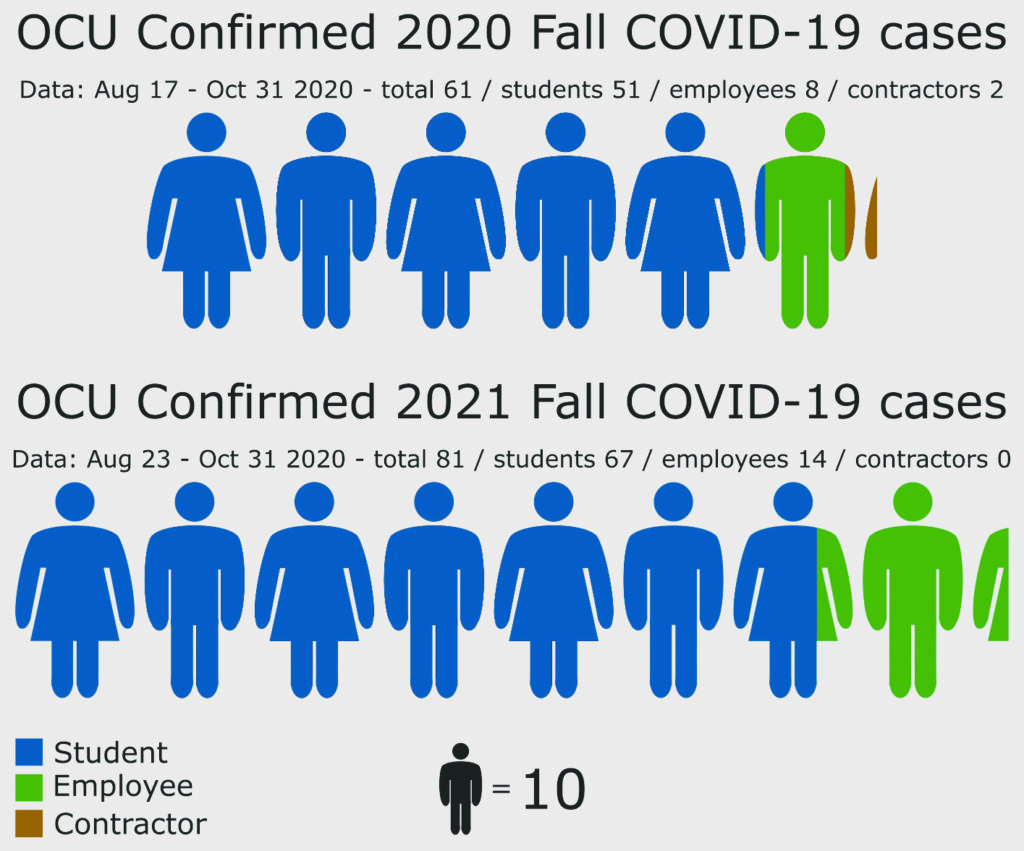
Comparing OCU’s COVID-19 case data from August–October 2020 to the same months in 2021 showed an increase in positive cases. Total positive cases for students, faculty members, and contractors for the 2020 time frame was 61. Compared to this, 2021 showed a total of 81 for the same statistic. The data for 2021 also reflected how many students and faculty members in this total of 81 positive COVID cases were fully vaccinated (no contractors contributed to the total for 2021).
The statistic’s increase may seem incongruent with the OCU Alert Level staying green, which symbolizes a low alert, for this frame of 2021 months. Throughout the 2020 time frame, the alert level demonstrated more severe gradients, yet the objective number of cases was lower when compared to this year. Rod Jones of OCU Media Relations provided insight into these statistics and how considerations of alert level and campus protocols are impacted by positive case numbers.
“The number of positive cases is not the only factor to consider when making a determination regarding health and safety protocol,” Jones said. The change in alert level reflected the overall campus concern for COVID-19 mitigation protocols and the risk posed by the virus to individuals. This year, in stark contrast to fall of 2020, vaccines are widely available to students. This contributes to the lower alert level, in spite of higher case counts.
“Last year, the university was in a more restrictive posture related to health and safety protocols. Social distancing was implemented in all classroom settings as well as outside the classroom. Event restrictions were also in place. Remote learning and working options were also widely available,” Jones said. “This year, the university is operating at full or near full capacity, with few restrictions for events although additional safety protocols are in place, social distancing is recommended when practical.” Likely the largest factor in positive cases increasing was the return to more standard campus activities this year, after a restrictive 2020.
As students had the opportunity to attend more classes, events, and large gatherings in person, the risk of transmitting the virus increased. Additionally, Jones suggested that individuals who were fully vaccinated may have made more bold or risky decisions, opposed to prior decisions that would prevent the spread of a virus, feeling more confident because of their vaccinated status. The positive cases in 2021 demonstrate nearly half of the positive student cases were individuals who were fully vaccinated.
Another contribution to the rise in cases was the Delta variant of the virus. “The delta variant is also at play this year which is even more contagious than the original and alpha variant, even among the fully vaccinated,” Jones explained.
Finally, one possible contribution to the higher case rates this year is the implementation of proactive residential testing. In Fall 2020, this was not occurring. Students who may have tested positive for COVID-19 may not have experienced strong enough symptoms to be tested, or may have attributed symptoms to another cause. Some individuals experience no obvious symptoms from the virus. Proactive testing has prevented positive cases from going unnoticed. This suggests the lower positive case count in 2020 may not have fully and completely reflected the data for the time.


Leave a Reply